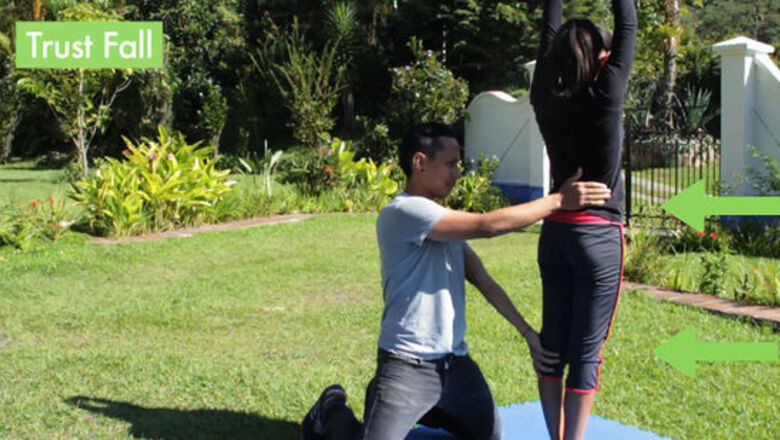
views
Preparing to Do a Back Handspring
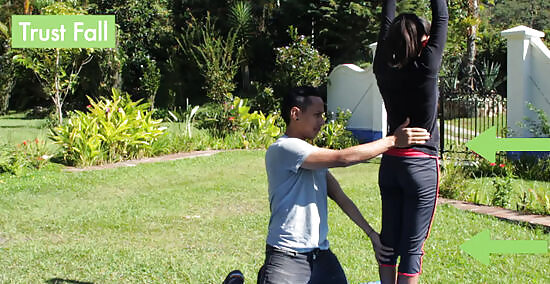
Get a spotter. If you’ve never tried a back handspring before, then your best bet is to practice at the gym with your gymnastics coach or another professional. However, if you feel confident enough to do the back handspring at home, then you should make sure to get a spotter to help you when you’re starting out. You will find that most people recommend you use a trampoline. Having a spotter will keep you from injuring yourself, overstepping your bounds, and hurting your head, neck, or back. Ideally, your spotter should also be a fellow gymnast or cheerleader, so he or she is familiar with what to do. Your spotter should place a hand on your lower back while placing the other under your thighs as you flip backwards. Stand by your spotter with your legs, feet, and knees nearly together and your arms in front of you. First, do a “trust fall” back into your spotter’s arms just to make sure that he or she can handle your weight. Ideally, there should be a soft mat behind you so you don’t hurt yourself if you fall. At first, your spotter will do some of the work for you, helping to flip your body over by pushing your back and your thighs up as you flip backwards. However, once you’re comfortable on your own, the spotter should only be there to make you feel safe, not to actually help you.
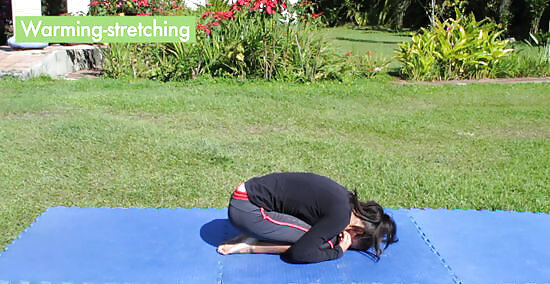
Stretch well. You may be eager to get started on your back handspring, but any experienced gymnast or cheerleader will tell you that stretching is vital to your success and safety, even if you’re only doing a somersault. It’s important to warm up a bit and to get your blood flowing before you go into a full-on back handspring. Though stretching all of your body is important, you can focus on stretching your legs, your arms, and your neck, as well as your wrists. Here are some stretches you can try before doing a back handspring: Stretch your back by doing a back bend. Then, do a counter-stretch by curling up into a ball on the floor and hugging your knees to roll out your back. For an extra stretch in your back, stand up and touch your toes. Roll your head clockwise five times and then counter-clockwise five times, to stretch your neck a bit. You can also roll your shoulders forward and backward. Place one hand in front of you, as if you were saying “Stop!” and then gently pull back the fingers of that hand with your other hand. Repeat with the other hand to get a deep stretch in your wrists. Then, roll your wrists clockwise five times and counter-clockwise five times to finish stretching them. Sit down and roll your ankles clockwise and counterclockwise. You can even spell the alphabet with each of your feet to get a full stretch.
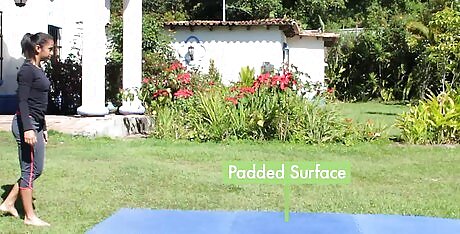
Use a padded surface. The best thing you can do is to bring home a thick gym mat, which will give you some cushioning without letting you sink in too far, as a mattress would. If you don’t have that, consider using a long couch cushion or a mattress, while being careful not to sink into them too much — if you don’t have enough momentum, you may end up falling back into the handstand position and then sinking in to the floor instead of springing up. You can also consider using a trampoline, if you have one, to give yourself the confidence to use a harder surface. Just remember that you won’t need nearly as much momentum to fall backward on a trampoline. If you’re trying the back handspring outside in your yard, pick a softer surface, like a grassy surface that’s a little pliable, instead of concrete or another harder surface that won’t give.
Doing a Back Handspring

Stand with your arms out in front of you. Keep your feet about hip distance apart and look straight ahead of you, in front of the tips of your fingers. Your hands should be about parallel to the ground when they’re in front of you. Keep your back straight, with a slight bend in your knees, preparing to lower yourself down. You can also start in the true starting position, with your arms raised over your head, by your ears, before you move them down to be parallel to the ground before you swing them up again.
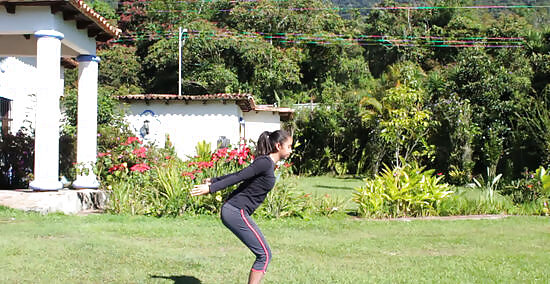
Get in a sitting position while starting to swing your arms over your head. Now, you can bend those knees further, as if you were lowering yourself into a chair. Place those knees directly over your feet to help yourself generate some momentum. As you do this, you should swing your arms over your head to help generate momentum as you swing backward. It can be helpful to practice the first two poses so you get the logistics down before you to try jump right in to the back handspring. It’s important to start with a strong foundation, so you’re generating enough momentum and maintaining proper form throughout the back handspring.
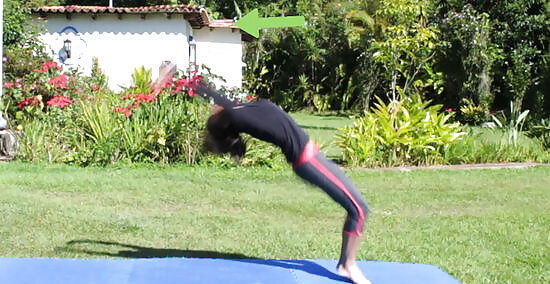
Continue swinging your arms over your head as you push through your toes. Now, let your arms swing until they reach over your head while pushing through your toes to give yourself that extra upward momentum. You should lean your arms back as far as they will go; there’s no need to worry about landing your arms right near the place where your feet stood, because you’ll have to fall back a bit. As you swing your arms up, you should make sure to keep them by your ears. Make sure to tighten your shoulder and arm muscles and raise your head back between your arms.
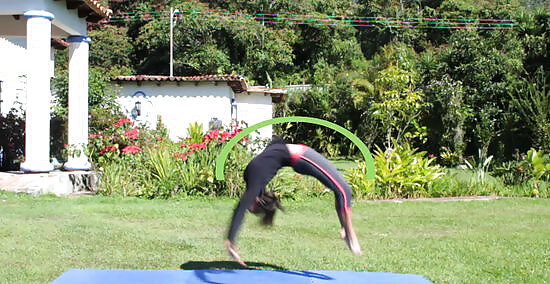
Continue to fall backwards. As you do this, make sure you don’t arch your back too much — there should be at least 2 feet (0.6 m) between the place where you start and the place where you land your hands. If you land those hands too close to your feet, then you will risk injuring yourself. Arching your back too much is known as undercutting and it could cause you to sprain your back when you land. Your legs should continue to drive you backward and upward at the same time. Extend through your ankles while pointing your toes. Continue to keep your head between your arms as you get closer to the floor.

Plant your hands on the floor. As you finish falling backwards with an arched back, you should keep your arms straight and even with your head so your arms touch the floor, instead of your head. The momentum in your legs, along with that of your lower body, should carry you over. Keep your fingers pointing away and up from your face, with your palms staying flat on the ground, on either side of your head. When you plant your hands on the floor, don’t put all of your pressure into your wrists. Instead, use the pads of your fingers and your palms for support. Otherwise, you risk injuring your wrists. At this point, your legs may still be out in front of you, but your body will soon be almost straight, in a handstand-position.

Swing your legs over your hands. Now, you’ll find yourself in what is essentially the handstand position for a second. You should swing your legs over your head so that they are straight up in the air, in a handstand position, as they continue to swing downwards. Though you won’t actually “hold” the position because the back handspring is a continuous motion, your body will be in this position briefly as you move toward finishing the back handspring. Keep your feet together or as close together as they can be, and keep your shoulders strong to support your body weight. You shouldn’t lock your knees, but work to keep your legs as straight as possible.
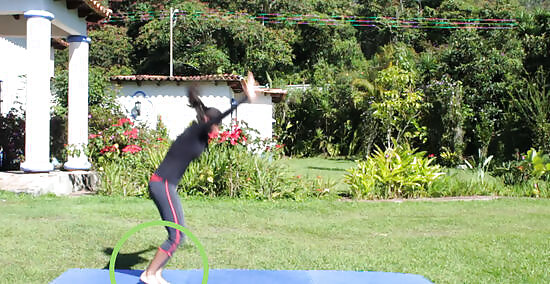
Plant your feet on the floor. Your legs should swing over your arms and torso and all the way down to the floor. Make sure to snap them firmly down to the floor while your upper body remains straight as it begins to shift upward. Your feet should be about shoulder width apart, with your toes pointing straight in front of you, just in the same position that you started in. You’ll land with your knees slightly bent and will straighten out as you finish the move. As your feet drift toward the floor, your upper body should prepare to pop upward. You’ll literally “spring” up as your feet hit the floor. Your arms and upper body should move upward just as your feet hit the floor.
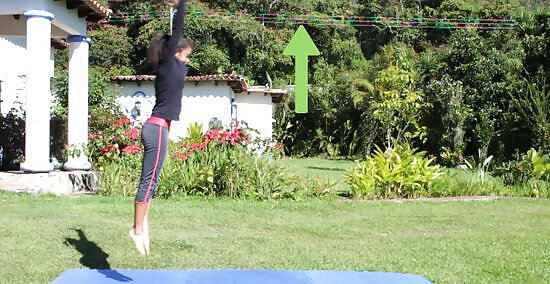
Pop up. As you land, pop your body up and swing your arms straight in front of you, and then up over your head, in order to strike the finishing pose with your arms up over your head, and your feet touching with your back straight. Though your first back handspring may not be exactly what you were hoping for, with practice, you’ll be able to execute it as well as you can.

Keep practicing. It takes lots of practice to get the back handspring down. Once you’re comfortable enough doing the back handspring without a spotter, you can practice at home on your own, with a comfortable surface. You can work on getting the timing down, so you can reach your arms over your head and fall backwards without enough momentum to “spring” forward to execute the move. Aim to do a dozen back handsprings a day and you’ll be able to master the technique. One common problem with the back handspring is falling backwards to one side. Make sure your feet and arms are parallel so you don’t fall to the left or right and end up with an uneven back handspring. Remember to arch your back, but not too much. Another common problem with the back handspring is that you’ll arch your back so much that you’ll end up finishing almost where you started, creating a move that looks almost like a back flip, and risking injury. You may also have trouble generating enough momentum to do a back handspring on your own. If that’s the case, you may want to practice doing a round-off backhandspring so you have enough momentum to spring upward.

















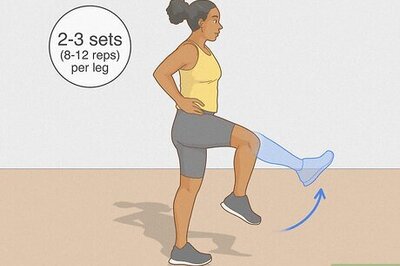


Comments
0 comment